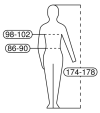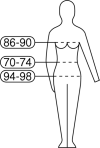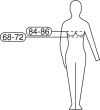EN 13402-2: Primary and secondary dimensions
The second part of the standard defines for each type of garment one "primary dimension". This is the body measure according to which the product must be labelled.
For some types of garment, a single measure may not be sufficient to select the right product. In these cases, one or two "secondary dimensions" can be added to the label.
The following table shows the primary and secondary dimensions listed in the standard. Secondary dimensions are shown in parenthesis.
| Garment | Men | Women | Boys | Girls |
|---|---|---|---|---|
| Jackets | chest girth (height, waist girth) |
bust girth (height, hip girth) |
height (chest girth) |
height (bust girth) |
| Suits | chest girth, waist girth (height, inside leg length) |
bust girth (height, hip girth) |
height (chest girth) |
height (bust girth) |
| Overcoats | chest girth (height) |
bust girth (height) |
height (chest girth) |
height (bust girth) |
| Trousers/shorts | waist girth (height, inside leg length) |
waist girth (height, hip girth, inside leg length) |
height (waist girth) |
height (waist girth) |
| Skirts | waist girth (height, hip girth) |
height (waist girth) |
||
| Dresses | bust girth (height, hip girth, waist girth) |
height (bust girth) |
||
| Knits: cardigans, sweaters, T-shirts | chest girth (height) |
bust girth (height) |
height (chest girth) |
height (bust girth) |
| Shirts | neck girth (height, arm length) |
height (neck girth) |
||
| Blouses | bust girth (height) |
height (bust girth) |
||
| Underpants | waist girth (height) |
waist girth (height, hip girth) |
height (waist girth) |
height (waist girth) |
| Vest | chest girth (height) |
bust girth (height) |
height (chest girth) |
height (bust girth) |
| Pyjamas Ladies' nightdresses |
chest girth (height, waist girth) |
bust girth (height, waist girth, hip girth) |
height (chest girth) |
height (bust girth) |
| Swim-suits/wear and bodies | waist girth (height, chest girth) |
bust girth (height, hip girth, underbust girth) |
height (chest girth, waist girth) |
height (underbust girth, bust girth) |
| Bras | underbust girth, bust girth (cup size) |
underbust girth, bust girth (cup size) |
||
| Corsetry/upper and full body | underbust girth, bust girth (height, hip girth, waist girth) |
|||
| Corsetry/lower body | waist girth, hip girth (height) |
|||
| Pantyhose | height (waist girth, weight) |
height | height | |
| Stockings | foot length | |||
| Socks | foot length | |||
| Gloves | hand girth | |||
| Head wear | head girth | |||
EN 13402-3: Measurements and intervals
The third part of the standard defines preferred numbers of primary and secondary body dimensions.
The product should not be labelled with the average body dimension for which the garment was designed (i.e., not "height: 176"). Instead, the label should show the range of body dimensions from half the step size below to half the step size above the design size (e.g., "height: 172-180").
For heights, for example, the standard recommends generally to use the following design dimensions, with a step size of 8 cm:
| Height | ... | 160 | 168 | 176 | 184 | 192 | 200 | ... |
|---|---|---|---|---|---|---|---|---|
| Range | ... | 156-164 | 164-172 | 172-180 | 180-188 | 188-196 | 196-204 | ... |
For trousers, the recommended step size for height is 4 cm:
| Height | ... | 156 | 160 | 164 | 168 | 172 | 176 |
|---|---|---|---|---|---|---|---|
| Range | ... | 154-158 | 158-162 | 162-166 | 166-170 | 170-174 | 174-178 |
| Height | 180 | 184 | 188 | 192 | 196 | 200 | ... |
|---|---|---|---|---|---|---|---|
| Range | 178-182 | 182-186 | 186-190 | 190-194 | 194-198 | 198-202 | ... |
The standard defines similar tables for other dimensions and garments, only some of which are shown here.
Men
The standard sizes and ranges for chest and waist girth are:
| Chest girth | 84 | 88 | 92 | 96 | 100 | 104 | 108 | 112 |
|---|---|---|---|---|---|---|---|---|
| Range | 82-86 | 86-90 | 90-94 | 94-98 | 98-102 | 102-106 | 106-110 | 110-114 |
| Waist girth | 72 | 76 | 80 | 84 | 88 | 92 | 96 | 100 |
| Range | 70-74 | 74-78 | 78-82 | 82-86 | 86-90 | 90-94 | 94-98 | 98-102 |
| Chest girth | 116 | 120 | 126 | 132 | 138 | 144 |
|---|---|---|---|---|---|---|
| Range | 114-118 | 118-123 | 123-129 | 129-135 | 135-141 | 141-147 |
| Waist girth | 104 | 108 | 114 | 120 | 126 | 132 |
| Range | 102-106 | 106-111 | 111-117 | 117-123 | 123-129 | 129-135 |
The above table is for drop = −12 cm, where
- drop = waist girth − chest girth.
Example: While manufacturers will typically design clothes for chest girth = 100 cm such that it fits waist girth = 88 cm, they may also want to combine that chest girth with neighbouring waist girth step sizes 84 cm or 92 cm, to cover these drop types (−16 cm and −8 cm) as well.
The standard also suggests that neck girth can be associated with chest girth according to this table:
| Neck girth | 37 | 38 | 39 | 40 | 41 | 42 | 43 | 44 |
|---|---|---|---|---|---|---|---|---|
| Range | 36.5-37.5 | 37.5-38.5 | 38.5-39.5 | 39.5-40.5 | 40.5-41.5 | 41.5-42.5 | 42.5-43.5 | 43.5-44.5 |
| Chest girth | 88 | 92 | 96 | 100 | 104 | 108 | 112 | 116 |
| Neck girth | 45 | 46.5 | 48 | 49.5 | 51 |
|---|---|---|---|---|---|
| Range | 44.5-45.8 | 45.8-47.3 | 47.3-48.8 | 48.8-50.3 | 50.3-51.1 |
| Chest girth | 120 | 126 | 132 | 138 | 144 |
The standard further suggests that arm length can be associated with height according to this table:
| Height | 156 | 160 | 164 | 168 | 172 | 176 | 180 | 184 | 188 | 192 | 196 | 200 |
|---|---|---|---|---|---|---|---|---|---|---|---|---|
| Arm length | 60 | 61 | 62 | 63 | 64 | 65 | 66 | 67 | 68 | 69 | 70 | 71 |
| Range | 59-60 | 60-61 | 61-62 | 62-63 | 63-64 | 64-65 | 65-66 | 66-67 | 67-68 | 68-69 | 69-70 | 70-71 |
Women
Dress sizes
The standard sizes and ranges for bust, waist and hip girth are:
| Bust girth | 76 | 80 | 84 | 88 | 92 | 96 | 100 | 104 | 110 |
|---|---|---|---|---|---|---|---|---|---|
| Range | 74-78 | 78-82 | 82-86 | 86-90 | 90-94 | 94-98 | 98-102 | 102-107 | 107-113 |
| Waist girth | 60 | 64 | 68 | 72 | 76 | 80 | 84 | 88 | 94 |
| Range | 58-62 | 62-66 | 66-70 | 70-74 | 74-78 | 78-82 | 82-86 | 86-91 | 91-97 |
| Hip girth | 84 | 88 | 92 | 96 | 100 | 104 | 108 | 112 | 117 |
| Range | 82-86 | 86-90 | 90-94 | 94-98 | 98-102 | 102-106 | 106-110 | 110-115 | 115-120 |
| Bust girth | 116 | 122 | 128 | 134 | 140 | 146 | 152 |
|---|---|---|---|---|---|---|---|
| Range | 113-119 | 119-125 | 125-131 | 131-137 | 137-143 | 143-149 | 149-155 |
| Waist girth | 100 | 106 | 112 | 118 | 124 | 130 | 136 |
| Range | 97-103 | 103-109 | 109-115 | 115-121 | 121-127 | 127-133 | 133-139 |
| Hip girth | 122 | 127 | 132 | 137 | 142 | 147 | 152 |
| Range | 120-125 | 125-130 | 130-135 | 135-140 | 140-145 | 145-150 | 150-155 |
Bra sizes
See the Bra Glossary
The standard sizes for brassiere are:
| Underbust girth | 60 | 65 | 70 | 75 | 80 | 85 | 90 | 95 |
|---|---|---|---|---|---|---|---|---|
| Range | 58-62 | 63-67 | 68-72 | 73-77 | 78-82 | 83-88 | 88-92 | 93-98 |
| Underbust girth | 100 | 105 | 110 | 115 | 120 | 125 |
|---|---|---|---|---|---|---|
| Range | 98-102 | 103-108 | 108-112 | 113-118 | 118-122 | 123-128 |
The secondary dimension cup size can be expressed in terms of the difference
- cup size = bust girth − underbust girth
and can be labelled compactly using a letter code appended to the underbust girth:
| Code | AA | A | B | C | D | E | F | G |
|---|---|---|---|---|---|---|---|---|
| Cup size range | 10-12 | 12-14 | 14-16 | 16-18 | 18-20 | 20-22 | 22-24 | 24-26 |
Example: Bra size 70B is suitable for women with underbust girth 68-72 cm and bust girth 84-86 cm.
Letter codes
For clothes where a larger step size is sufficient, the standard also defines a letter code. This code represents the bust girth for women and the chest girth for men. The standard does not define such a code for children.
| Meaning | Code | Chest girth (men) | Bust girth (women) |
|---|---|---|---|
| extra extra small | XXS | 70-78 | 66-74 |
| extra small | XS | 78-86 | 74-82 |
| small | S | 86-94 | 82-90 |
| medium | M | 94-102 | 90-98 |
| large | L | 102-110 | 98-106 |
| extra large | XL | 110-118 | 107-119 |
| extra extra large | XXL | 118-129 | 119-131 |
| extra extra extra large | 3XL | 129-141 | 131-143 |
Each range combines two adjacent size steps. The ranges could be extended below XXS or above 3XL if necessary, for example:
| Code | Chest girth (men) | Bust girth (women) |
|---|---|---|
| 4XL | 141-154 | 143-155 |
| 5XL | 154-166 | 155-167 |
EN 13402-4: Coding system
The fourth part of the standard is still under review and is expected to be published in late 2007. It will define a compact coding system for clothes sizes. This was originally intended primarily for industry use in databases and as a part of stock-keeping identifiers and catalogue ordering numbers, but later users have also expressed a desire to use compact codes for customer communication. Writing out all the centimetre figures of all the primary and secondary measures from EN 13402-2 can
in some cases
require up to 12 digits. The full list of centimetre figures on the pictogram contains a lot of redundancy and the same information can be squeezed into fewer graphemes with lookup tables. EN 13402-4 will define such tables.
An earlier draft of this part of the standard attempted to list all in-use combinations of EN 13402-3 measures and assigned a short 2- or 3-digit code to each . Some of the industry representatives involved in the standardization process considered this approach too restrictive. Others argued that the primary dimension in centimetres should be a prominent part of the code. Therefore this proposal, originally expected to be adopted in 2005, was rejected.
Since then, several new proposals have been presented to the CEN working group. One of these, tabled by the European Association of National Organisations of Textile Traders (AEDT), proposes a 5-character alphanumeric code, consisting of the 3-digit centimetre figure of the primary body dimension, followed by one or two letters that code a secondary dimension, somewhat like the system already defined for bra sizes. For example, an item designed for
- bust girth: 100 cm (100)
- hip girth: 104 cm (B)
- height: 176 cm (G)
would bear (in addition to the explanatory pictogram) the compact size code "100BG". This proposal was agreed upon in a March 2006 meeting in Florence and a final draft was produced by AEDT on 6 June 2006.
You may also have interested in reading about US Clothing Size Standards: (1976) READER'S DIGEST: COMPLETE GUIDE TO SEWING, 1st ed., Reader's Digest Association. ASIN B000CQ2THY



